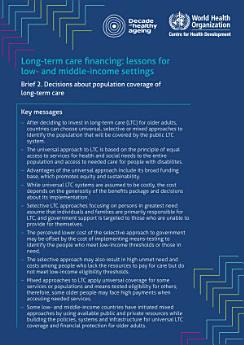Long-term care financing: lessons for low- and middle-income countries. Brief 2. Decisions about population coverage of long-term care
World Health Organization
Mar 2024 · World Health Organization
Ebook
11
Pages
family_home
Eligible
info
reportRatings and reviews aren’t verified Learn More
About this ebook
This brief is part of a series about financing health and social long-term care: lessons for low- and middle-income countries (LMICs). Countries take a universal or selective approach, or some mix of the two, in identifying the population that will be covered under LTC programmes. Decisions are based on the economic and social contexts, and LTC is designed with consideration of the existing infrastructure for delivering health and social care. Universal approaches are grounded in the principle of ensuring equal access to health and social care. Selective approaches focus on those in greatest need, primarily those who are low-income. While selective approaches are perceived to cost less, the total costs may be offset by the high cost of implementing means-testing to identify beneficiaries. The selective approach may also result in high levels of unmet needs among people who do not meet the low-income thresholds. Mixed universal and selective approaches enable universal coverage for some services or populations and means-tested eligibility for others; thus, older people may face high payments for some needed services. Many LMICs have initiated mixed approaches to LTC, using public and private resources while building the policies, systems and infrastructure for universal coverage of LTC.
Rate this ebook
Tell us what you think.
Reading information
Smartphones and tablets
Install the Google Play Books app for Android and iPad/iPhone. It syncs automatically with your account and allows you to read online or offline wherever you are.
Laptops and computers
You can listen to audiobooks purchased on Google Play using your computer's web browser.
eReaders and other devices
To read on e-ink devices like Kobo eReaders, you'll need to download a file and transfer it to your device. Follow the detailed Help Center instructions to transfer the files to supported eReaders.








